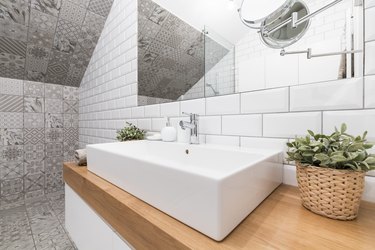
A curved or straight-sided expanse of porcelain sink can be a focal point in the kitchen and bathroom. But when it's marred with spots of rust around the plug or on the apron of the bowl, this can detract from the natural gleaming beauty of the fixture. Rust on a ceramic sink ledge or in the bowl isn't that difficult to remove. However, if you use the wrong type of rust stain remover, you can irreparably damage the pristine ceramic surface.
Safety Precautions Using Rust Removers
Video of the Day
Removing rust stains from sinks in bathrooms and kitchens can create safety issues. More than likely, the sink is located in a small space or has limited ventilation. Always use gloves and safety goggles when scrubbing away rust that will create free-floating small particles.
Video of the Day
The fine particles in steel wool can irritate your skin and fly up into your eyes when you are working on small spaces up close. Wear safety goggles and a good set of canvas or work gloves before grinding the rust stain away.
Paint fumes and overspray can cause respiratory issues when you are working in small spaces. Strong cleaners and rust removers can build up and choke clean air in a small work space. A good particle mask is highly recommended when working with flaking rust spots on the smooth surface of ceramic sinks.
Natural and Basic Rust Removers
If a can of shaving cream, hairspray or other beauty product with metal edging has created a rust stain on the sink edge, you can attack the issue with household astringents. A rusty kitchen sink drain or a bathroom drain that begins to bloom with rust can be cleaned up with simple and natural homemade rust removers.
Bob Vila recommends using a paste of 2 parts cream of tartar to 1 part 3 percent hydrogen peroxide to remove a light layer of rust without damaging the ceramic surface. Apply a thick layer with a damp sponge and let it sit for a couple of hours before wiping away with a clean, damp cloth towel.
For a rust stain remover that is noncaustic and affordable, a fresh lemon and layer of salt can make quick work of a newly created stain. Another method would be to sprinkle salt or baking soda on a cut half of a potato and rub it into the spot. For stubborn spots, let the treated potato sit on the spot overnight after rubbing it into the rusty area.
Rust Stains in Ceramic Sink
If the rust has created a serious issue, be prepared to put some time and effort into reversing the damage. To return the sink to its former glory, you will need to remove the top layer of the rust without damaging the sink.
A square of light sandpaper can remove the first layer of rust and discoloration. Use steel wool for difficult rust stains. Once the bulk of the rust has been removed, use an enamel repair product to make sure the rust doesn't spread from exposure to moisture in the sink. Then add a touch of epoxy or enamel spray paint to cover any leftover shadow of the rust's presence.
Commercial rust removers can be used when the area is large or old and stubborn. Spray a rust remover, such as CLR, on the area and let it sit before gently removing it with a clean towel. Follow up with a tub-and-tile refinishing kit to cover large divots or chips in the sink bowl or along the apron for a seamless finish.